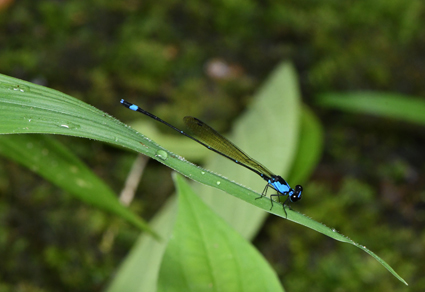Abstract
We examined the morphology, colour patterns and genetic relationships of Nososticta populations allied to N. salomonis (Selys) from across Melanesia. Seven species-level taxa are recognised in the N. salomonis ‘complex’: N. africana (Schmidt), N. boonei sp. nov., N. chrismulleri Theischinger & Richards, N. hedigeri sp. nov., N. salomonis (Selys), N. stueberi sp. nov., and N. tagula sp. nov. All of these species are black damselflies with blue markings, and they differ from all other Nososticta by having: 1) a prominent spike on the male superior appendage, 2) a prominent angular base of the male inferior appendage, and 3) a complex posterior lobe on the female pronotum bearing two pairs of processes in the rough shape of a chair when viewed laterally. A molecular phylogeny based on the DNA barcode fragment of the COI gene plus two nuclear genes indicates that these seven species are closely related, but more extensive sampling of Nososticta species is required to confirm that they form a monophyletic group.
References
- Brass, H.G. (1956) Results of the Archbold Expeditions No. 75. Summary of the Fourth Archbold Expedition to New Guinea (1953). Bulletin of the American Museum of Natural History, 111 (2), 81–151.
- Chao, H.F. (1953) The external morphology of the dragonfly Onychogomphus ardens Needham. Smithsonian miscellaneous Collections, 122 (6), 1–56.
- Darriba, D., Taboada, G.L., Doallo, R. & Posada, D. (2012) jModelTest 2: more models, new heuristics and parallel computing. Nature Methods, 9 (8), 772. https://doi.org/10.1038/nmeth.2109
- DeSalle, R. & Goldstein, P. (2019) Review and interpretation of trends in DNA barcoding. Frontiers in Ecology and Evolution, 7, 302. https://doi.org/10.3389/fevo.2019.00302
- Foerster, F. (1998) Odonaten aus Neu-Guinea. Termeszentrajzi Füzetek, 21, 271–302.
- Gassmann, D. (2015) Odonata recorded from northeastern Papua New Guinea including the Bismarck Archipelago in May to July 1997. Faunistic Studies in South-East Asian and Pacific Island Odonata, 10, 1–46.
- Kalkman, V.J. & Orr, A. (2013) Field guide to the damselflies of New Guinea. Brachytron, 16 (supplement), 3–120.
- Kearse, M., Moir, R. & Wilson, A. (2012) Geneious Basic: An integrated and extendable desktop software platform for the organization and analysis of sequence data. Bioinformatics, 28 (12), 1647–1649.
- https://doi.org/10.1093/bioinformatics/bts199
- Koroiva, R. & Kvist, S. (2018) Estimating the barcoding gap in a global dataset of cox1 sequences for Odonata: close, but no cigar. Mitochondrial DNA, Part A, 18 (5), 765–771. https://doi.org/10.1080/24701394.2017.1357709
- Kumar, S., Stecher, G., Li, M., Knyaz, C. & Tamura, K. (2018) MEGA X: Molecular Evolutionary Genetics Analysis across computing platforms. Molecular Biology and Evolution, 35, 1547–1549.
- https://doi.org/10.1093/molbev/msy096
- Lawrence, D.R. (2014) The Naturalist and His ‘Beautiful Islands’: Charles Morris Woodford in the Western Pacific. ANU Press, Canberra, xiv + 420 pp. https://doi.org/10.22459/NBI.10.2014
- Lieftinck, M.A. (1932) The dragonflies (Odonata) of New Guinea and neighbouring islands, Part I: Descriptions of new genera and species of the families Lestidae and Agrionidae. Nova Guinea, 15 (3), 485–602.
- Lieftinck, M.A. (1949) The dragonflies (Odonata) of New Guinea and neighbouring islands. Part VII. Results of the Third Archbold expedition 1938-1939 and of the Le Roux Expedition 1939 to Netherlands New Guinea (II. Zygoptera). Nova Guinea, New Series, 5, 1–271.
- Mathew, G.F. (1887) Descriptions of some new species of Rhopalocera from the Solomon Islands. Transactions of the Entomological Society of London, 1887, 37–49. https://doi.org/10.1111/j.1365-2311.1887.tb00919.x
- Michalski, J. (2012) A manual for the identification of the dragonflies and damselflies of New Guinea, Maluku and the Solomon Islands. Kanduanum Press, Morristown, New Jersey, 579 pp.
- Mitchell, A. (2008) DNA barcoding demystified. Australian Journal of Entomology, 47 (3), 169–173. https://doi.org/10.1111/j.1440-6055.2008.00645.x
- Mitchell, A. (2015) Collecting in collections: a PCR strategy and primer set for DNA barcoding of decades-old dried museum specimens. Molecular Ecology Resources, 15, 1102–1111. https://doi.org/10.1111/1755-0998.12380
- Mitchell, A. & Samways, M.J. (2005) The morphological ‘forms’ of Palpopleura lucia (Drury) are separate species as evidenced by DNA sequencing (Anisoptera: Libellulidae). Odonatologica, 34, 173–178.
- Ogden, T. & Whiting, M.F. (2003) The problem with “the Paleoptera Problem:” sense and sensitivity. Cladistics, 19, 432–442. https://doi.org/10.5962/bhl.part.26082
- Pinhey, E.C.G. (1962) A descriptive catalogue of the Odonata of the African Continent (up to December 1959), parts I & II. Publicacoes culturais da Companhia di Diamantes de Angola, 59, 11–161, pls. 1–5, 163–322, pls. 6–9.
- Ris, F. (1900) Libellen from Bismarck-Archipel. Entomologische Nachrichten, 24, 321–327. https://doi.org/10.5962/bhl.part.26082
- Ris, F. (1913) Odonata von den Aru- und Kei-Inseln, gesammelt durch Dr.H. Merton 1908 nebst—übersicht über die von den Aru-Inseln bekannten Odonaten. Abhandlungen herausgegeben von der Senckenbergischen Natuforschenden Gesellschaft, 34, 501–536.
- Ronquist, F. & Huelsenbeck, J.P. (2003) MrBayes 3: Bayesian phylogenetic inference under mixed models. Bioinformatics, 19, 1572–1574.
- https://doi.org/10.1093/bioinformatics/btg180
- Schmidt, E. (1944) Die erste afrikanische Notoneura-Art (Ordn. Odonata). Mitteilungen der Deutschen Entomologischen Gesellschaft, E.V., 12, 43–45.
- Selys-Longchamps de, M.E. (1886) Revision du Synopsis des Agriones. Première partie comprenant les légions Pseudostigma, Podagrion, Platycnemis et Protonevra. Mémoires couronnés et autres Mémoires de l’Académie de Belgique, 38 (4), [1] + i–iv + 1–233.
- Stamatakis, A. (2006) RAxML-VI-HPC: Maximum Likelihood-based phylogenetic analyses with thousands of taxa and mixed models. Bioinformatics, 22, 2688–2690. https://doi.org/10.1093/bioinformatics/btl446
- Tennent, J. (2002) Butterflies of the Solomon Islands: Systematics and Biogeography. Norfolk. Storm Entomological Publishing, Dereham,413 pp.
- Theischinger, G. & Richards, S.J. (2015) The genus Nososticta Hagen (Odonata: Platycnemididae) from the Papuan region with descriptions of ten new species group taxa. Odonatologica, 44, 153–224.
- Theischinger, G. & Richards, S.J. (2016) Six new species of Nososticta Hagen, 1860 from Papua New Guinea (Odonata: Platycnemididae). Odonatologica, 45, 291–316.
- Van der Weele, H.W. (1906) Neuropteroidea. in: Resultats de l’expedition scientifique neerlandaise a la Nouvelle Guinee. Nova Guinea, 5 (Zoologie), 385–388.
- Watson, J.A.L. & O’Farrell, F.A. (1991) Odonata (dragonflies and damselflies). In: CSIRO Division of Entomology (Ed.), The insects of Australia. A textbook for students and research workers. 2nd Edition. Melbourne University Press, Carlton, pp. 294–310.


